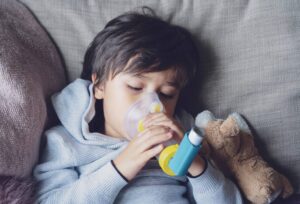Table of Contents
A child having a reaction to eating food is dreaded by parents everywhere. Learning to read food labels, questioning ingredients when eating at restaurants or other people’s homes, and being prepared for a rapid or life-threatening reaction all become part of daily life for parents of children with food allergies. Food allergies are a growing safety and public health concern worldwide. Approximately 8% of children (1 in 13 children) in the United States are allergic to at least one food. Depending on the allergen, many children may outgrow their allergy in early childhood. For those who do not outgrow their allergy, completely avoiding foods containing the allergen and emergency preparedness with EpiPens (epinephrine) is currently the gold standard of managing childhood food allergies.
However, maintaining this standard of care is tiring and doesnt do much for addressing quality of life or reducing the risk of what could happen if your child is exposed.
Food allergen immunotherapy is an additional treatment option that aims to address these concerns through increasing tolerance to allergens, improving quality of life for children and their families, and reducing the risk and fear of severe reactions. Not everyone is eligible for food immunotherapy, but for those who do utilize it, about 80% experience success.
Understanding how immunotherapy works, the different types of immunotherapy currently available and in the works, and how undergoing immunotherapy might improve quality of life for your child and family, may help you and your pediatric allergist or allergy care team determine if this treatment option is right for you.
Understanding Food Allergies
In order to understand how food immunotherapy works, it is first important to understand the process involved in food allergies. A food allergy is an immune system response to something the body deems as dangerous. When an allergen is ingested, the immune system deploys a variety of components including antibodies (called immunoglobulins) and white blood cells that cause a range of symptoms ranging from mild to severe. The symptoms and management of allergy symptoms depend on which types of immune cells are involved.
For the purpose of immunotherapy, it is most important to understand the process of immunoglobulin E (IgE). This antibody is released into the bloodstream and circulates within minutes, causing symptoms such as swelling and itching of the tongue and mouth, runny nose or watery eyes, increased heart rate, difficulty breathing, coughing, wheezing, vomiting, and even loss of consciousness, shock, or death.
A mild IgE-mediated allergy may not extend beyond itching or tingling of the tissue of the mouth and face and may resolve quickly once the offending food is swallowed and no more is ingested. A more severe IgE response involves swelling of the airway and anaphylaxis, a medical emergency which causes system-wide symptoms such as rapidly dropping blood pressure, increased heart rate, tongue or airway swelling, skin rash, shock, unconsciousness, and if not addressed quickly, death.
How are Food Allergies Managed?
A common and popular way of managing food allergies involves elimination diets. Elimination diets treat food allergies by avoiding contact with the triggering food, thus avoiding the release of IgE and the undesirable symptoms that come with it. If exposure does occur, treatment with epinephrine (EpiPen) works to counteract the effects of IgE, reducing itching and swelling, particularly of the airways. The effects of epinephrine are short lived, and the allergic response may outlast the aid of an EpiPen, so seeking emergency care for close monitoring is always necessary after an EpiPen has been used. This can be an incredibly stressful concept for families, especially those with small children who are not even old enough to understand they have a food allergy. There are countless scenarios when a child could unknowingly take food containing an allergen at school, daycare, birthday parties, or restaurants. The need to be vigilant, ask questions, and read food labels is constant and often overwhelming.
What is Immunotherapy?
Food immunotherapy takes a completely different approach to managing food allergies and aims to desensitize your child to their triggering foods, building a tolerance for how much they can ingest before IgE release occurs, and decreasing the severity of the reaction altogether. Treatment with immunotherapy involves daily exposure to small amounts of the allergen; the dose is increased slowly over a period of weeks to months. Over time, the body develops a tolerance to the food, allowing larger and larger amounts of exposure without triggering the immune system. This is not a cure for food allergies; however, when food immunotherapy is effective, it results in lowered risk of serious reaction if your child is accidentally exposed to an allergen or takes a few bites of a food they are allergic to.
Food immunotherapy has always been around in a variety of forms, but it is only in recent years that big strides have been made in broadening and standardizing how it is delivered. These advancements have led to safer and more effective treatment options for patients with food allergies.
Currently, there are several different methods of food delivery available for eligible children including oral immunotherapy, sublingual (under the tongue) immunotherapy, and epicutaneous (on the skin) immunotherapy. Subcutaneous (under the skin) immunotherapy, which is the fourth type of immunotherapy, is being investigated and newer experimental approaches are being considered. Oral, sublingual, and epicutaneous immunotherapy are discussed more in depth below.
Oral Immunotherapy
Perhaps the most common and most extensively studied method of food immunotherapy is oral immunotherapy (OIT). This involves taking an allergen, usually in liquid or powder form, mixing it with applesauce or another food, and giving a very small and precisely measured amount of the mixture/food to a patient to eat.
An oral food challenge is typically performed to confirm if a child is truly allergic to a food and eligible for oral immunotherapy. Food challenges involve giving increasingly larger doses of a food and observing for a reaction. If an allergy is confirmed, then an OIT starting dose can be determined and the oral immunotherapy process may begin.
According to the Asthma and Allergy Foundation of America (AAFA), the first dose is given in the allergist’s office so your child can be closely observed for a reaction and emergency treatment provided if necessary. Often, the first dose is broken into four or five smaller doses which will be given over several hours of observation; this is called “initial dose escalation.” If your child tolerates this well, the total dose they consumed that day will then be repeated each day for two weeks at home.
Then your child will return to the allergist and have the dose increased; this is known as “up-dosing.” Over the next several months (usually around six), your child will increase their dosage every two weeks until they reach a maintenance dose. Dosage increases are typically done at the allergist’s office so your child can be observed for a reaction. If a reaction does occur, future doses will be adjusted at a more infrequent rate to reduce the risk of a reaction occurring again.
Once the maintenance dose is determined, your child will progress into the maintenance phase where they will eat a small, measured amount of the food every day, indefinitely, to maintain that level of tolerance and desensitization to the food. During the maintenance phase, you should have routine follow-ups with your pediatric allergist especially when you have any concerns. Make sure your allergist is easily accessible as a telehealth allergist or through other telemedicine capacities. If your allergist is a virtual-first allergist, you should have online access to their services while your child is in the indefinite maintenance phase. Be sure to consult with your pediatric allergist if you are thinking of discontinuing the daily “maintenance dose” because if you stop giving the daily dose of allergen protein, your child could become sensitized to the food again and have a reaction if exposed down the line.
Oral food challenges may be done intermittently throughout oral immunotherapy treatment to determine if your child is still allergic to the food, as many children do eventually outgrow their allergies.
OIT is fairly effective for allowing “bite-protection” for children with food allergies. This is not a cure for the allergy, but means if your child accidentally takes a bite of a food containing or contaminated with an allergen, they should be able to tolerate it without an allergic reaction. OIT achieves this goal for about 60-80% of children receiving it for peanut, milk, and egg allergies. OIT is not a guarantee of protection, and children with food allergies will still need to carry an EpiPen and try to avoid the food; this treatment option just offers an additional safety net to help prevent serious reactions.
Typically, OIT is for children over the age of four, but in certain cases it may be considered down to the first year of age. Children in good health and with at least one confirmed allergy may be eligible to try OIT. Not every food is available for OIT, but some of the most common ones include milk, egg, peanut, almond, pecan, cashew, pistachio, hazelnut, sesame, soy, and wheat. For children with multiple food allergies, there may be a limit on how many foods they can undergo OIT for at one time. Your child’s allergist will be able to help you determine for which foods, and in what order, OIT should be initiated. OIT is for children with IgE-mediated allergic responses. Other types of allergic responses, such as eosinophilic esophagitis, cannot be treated with OIT.
Benefits of OIT include the effectiveness most patients experience and the ability to experience childhood more freely without as much worry over accidental exposure at school, restaurants, birthday parties, or playdates with friends. Of course there are also risks involved, including side effects like nausea, stomach pain, vomiting, or diarrhea. Some children may experience mild itchy mouth or throat which can be managed with an over-the-counter antihistamine. There is also a risk of anaphylaxis due to the repeated exposure to your child’s allergen.
Careful dosing and observation are utilized to reduce this risk, but studies do show that children receiving OIT use their EpiPens more often than children not undergoing the process. For peanut allergies specifically, the risk of using epinephrine while undergoing OIT may be as high as 7.6% for those undergoing peanut oral immunotherapy (POIT).
Missing a dose for any reason also increases the risk of side effects and serious reaction to the next dose of OIT. Missed doses should always be reported to your child’s allergist.
The cost of OIT varies, but many commercial insurances will pay for the treatment. Without insurance, it can cost several thousand dollars per year. While OIT has been around for many years, the way the allergen is delivered (powder, liquid, actual pieces of food) varies and is not uniform across the country. Your pediatric allergist will individualize a plan that best fits your child’s needs.
Recently the U.S. Food and Drug Administration approved a standardized method of OIT delivery, PALFORZIA, a precisely dosed capsule containing peanut protein available for children ages four and older with a peanut allergy. Palforzia works similar to OIT, and although the potential benefits and risks are the same as other OIT treatment, Palforzia is just the first to be developed in widely available capsule form. Hopefully other allergen proteins will be available in the future as several are in development!
The cost of Palforzia varies and individual insurance plans may or may not cover the cost. Co-pay cards are available from the manufacturer and usually allow it to be purchased for around $20 per month. Speaking with your pediatric allergist and insurance can give you a better idea about expected costs and other considerations.
Sublingual Immunotherapy
Sublingual immunotherapy (SLIT) is a similar concept to OIT in that it uses progressively higher doses of an allergen to desensitize a patient and reduce the risk of serious reaction if a patient is accidentally exposed. SLIT differs in that it is administered under the tongue, either via a dissolving tablet or drops, and triggers the immune system in a slightly different way since the allergen is entirely taken up by the tissues of the mouth rather than being swallowed. SLIT for food allergies has been adopted from the existing FDA-approved treatment for environmental allergy such as ragweed and tree pollen, using tablets placed under the tongue for desensitization.
There are a few important differences between SLIT and OIT including a slightly lower rate of effectiveness of sublingual immunotherapy but reduced side effects compared to OIT.
SLIT is less effective than OIT, but even so, clinical trials currently indicate that around 60-70% of patients are able to pass oral food challenges in small amounts (the “one bite” rule) after reaching a maintenance dose. So, while OIT may be more effective, sublingual immunotherapy is still a viable option.
Around 9% of sublingual immunotherapy doses were accompanied by side effects, which were mostly itching of the tongue or mouth and, rarely, gastrointestinal symptoms, while about 43% of OIT doses are accompanied by side effects, with half being oropharyngeal symptoms (throat, tongue) and the other half being gastrointestinal symptoms. This makes sublingual immunotherapy a potentially appealing option for patients who are consistently bothered by the gastrointestinal symptoms of oral immunotherapy or children who have existing gastrointestinal conditions where those side effects would be undesirable.
SLIT is still in clinical trials and at this time, no FDA-approved products exist, meaning most commercial insurances would not cover sublingual immunotherapy, but actual cost may vary. It is being studied for patients down to the first year of age and includes treatment of peanut, hazelnut, peach, apple, and milk allergies.
Epicutaneous Immunotherapy
Another potential option that is still in the early stages of development is epicutaneous immunotherapy (EPIT). This method provides exposure to allergens through application of a precisely dosed patch that delivers allergy protein to the superficial layers of the skin. Skin cells absorb the allergen and bring it to the lymph system where the immune system can become desensitized through repeated exposures. This method is much more indirect than OIT or SLIT as the bloodstream absorption is very limited. Because of this, EPIT has a much smaller side effect profile and is generally considered safer than OIT and SLIT with regards to serious side effects like anaphylaxis. Epicutaneous immunotherapy may also be an appealing option for parents with children who are bly resistant to taking oral medication but are happy with a painless patch applied to the skin.
Current evidence suggests EPIT is just as effective as SLIT but has been shown to be less effective than OIT at one year of treatment, though it is believed the effectiveness may continue to grow beyond the one-year mark. Side effects of epicutaneous immunotherapy are typically limited to a local reaction to the patch site such as redness, irritation, or itching. Because of the low rates of absorption, more serious side effects such as difficulty with breathing or gastrointestinal upset are rare.
EPIT is another treatment still in trial stages, so the cost of treatment is not likely to be covered by commercial insurances yet. Patches are currently being developed for peanut, milk, and egg allergies. Similar to oral and sublingual immunotherapy, the doses of these patches will increase gradually (by increasing wearing time) until a maintenance dose is attained. Then the patch will be worn for 24 hours and changed daily.
While the concept of food immunotherapy has been around for many decades, well studied and regulated methods have only begun to be developed in recent years, so much is left to learn about these options. Immunotherapy does not offer a cure for food allergies, but may provide peace of mind and improve quality of life for children and families living with food allergies. While only one FDA-approved product (Palforzia) currently exists, several routes of allergy treatment for a variety of foods are available by working with a trained pediatric allergist. Immunotherapy of any type may also not be needed forever as many children outgrow their allergies. Up to 50% of children with cow’s milk allergy outgrow it by their first year and 90% outgrow it by age three. Around 80% of children eventually outgrow egg, milk, and wheat allergies as well. Nut and seafood allergies often last into adulthood and for life, with only 20% outgrowing those allergies in childhood. The risks, benefits, effectiveness, and cost of each method of immunotherapy can be discussed with your child’s pediatric allergist or allergy care group and the right course of action can be decided together.











